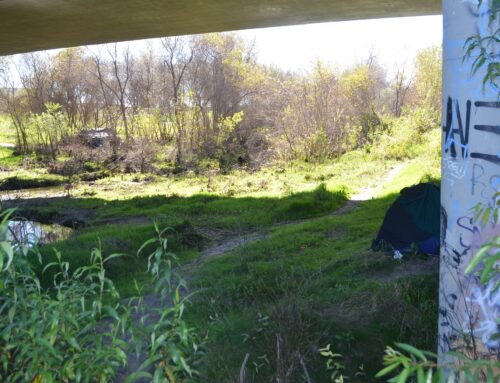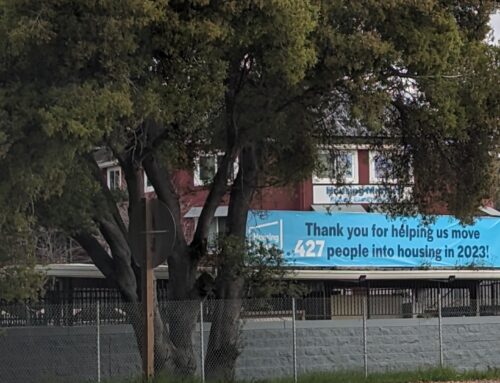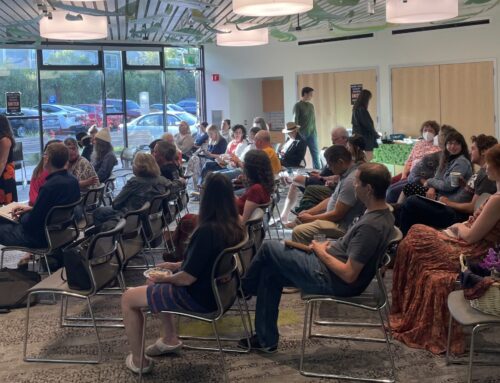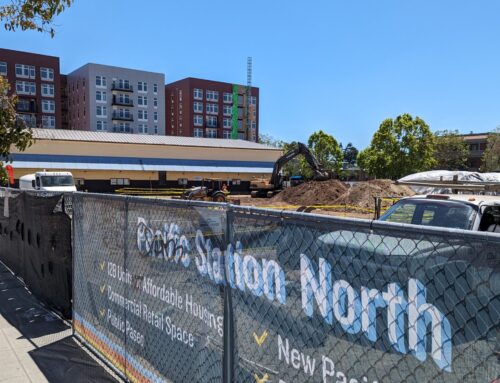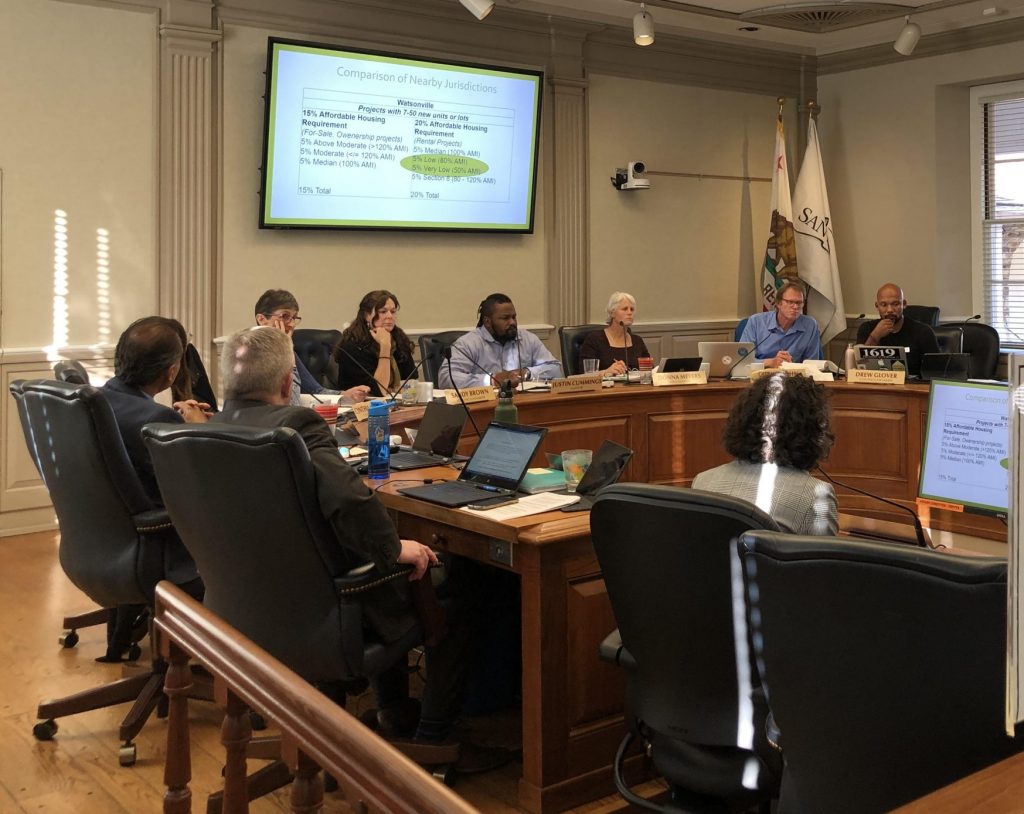
SANTA CRUZ >> When a new law takes effect in 30 days, Santa Cruz will have one of the highest affordability requirements in the region for market-rate developers.
The Santa Cruz City Council voted 4-3 in a second and final public hearing Tuesday to increase the number of affordable units that market-rate developers are required to build. It’s called an inclusionary rate. Beginning in February, developers will need to make 20% of new units available at affordable rates to people with lower incomes.
Tuesday, Santa Cruz Economic Development Director Bonnie Lipscomb proposed adding flexibility to the draft law previously approved Dec. 10 by the city council. She suggested a model similar to the City of Watsonville’s: explicitly allowing developers to set aside 5% of affordable units in a rental project for Section 8 tenants with lower incomes.
Lipscomb had met with Mayor Justin Cummings ahead of Tuesday’s meeting, but in the end did not get his support. Cummings and Councilmembers Sandy Brown, Drew Glover and Chris Krohn voted to move ahead with the more rigid 20% requirement. Vice Mayor Donna Meyers and Councilmembers Cynthia Mathews and Martine Watkins voted against it.
Lipscomb said the flexibility for Section 8 tenants would have provided more certainty for investors in market-rate projects. The developer and investors get a fair-market return from Section 8 tenants, since the state subsidizes those rents.
Lipscomb said in an interview after the meeting, “Going to the bank, if you had that specific language in there, it’s less risky for a bank to lend on that because they know there’ll be a guaranteed return one way or another. Either there’ll be a voucher that will then provide that market-rate rent, even though it’s a low-income tenant, or they’ll be able to market if there are no available Section 8 tenants. If there truly are a ton of Section 8 tenants, there’s no risk either way.”
DENSITY BONUS LAW
The city, like most others in the state, is well behind on its goals for production of housing units for people with very low incomes. One unintended consequence of the new law likely will be that no market-rate developers will use the state’s density bonus law to build very low-income units, unless other funding is available.
The state’s density bonus law is a package of incentives for housing developers. It allows developers to build taller and denser projects than local zoning allows if the project meets one of two criteria: 11% of the units are made available to people with very low incomes or 20% of the units are for people with lower incomes. “Lower income” means 80% of the area median income. The bonus also could include reduced parking requirements and other incentives.
The way Santa Cruz’s new law is written, market-rate developers automatically would qualify for the state’s density bonus since they would be required to build 20% of units as lower income. There is no incentive to build those very low income units, since the new law would require developers to not only build the 11% of units for people with very low incomes, but also 9% of units for people with lower incomes.
Also, since the new law requires projects to meet the minimum criteria for the state’s density bonus, developers will likely take the bonus, so future proposals would be denser than what we’ve typically seen, Planning Director Lee Butler said in an interview after the meeting.
Recently, market-rate developers in Santa Cruz have begun to take advantage of the state’s density bonus law. The recently-approved 190 W. Cliff project near the Dream Inn included 11% of units for people with very low incomes. The Front/Riverfront project, east of Front and Cathcart streets downtown, and another new proposal on Felix Street are seeking a density bonus, Butler said.
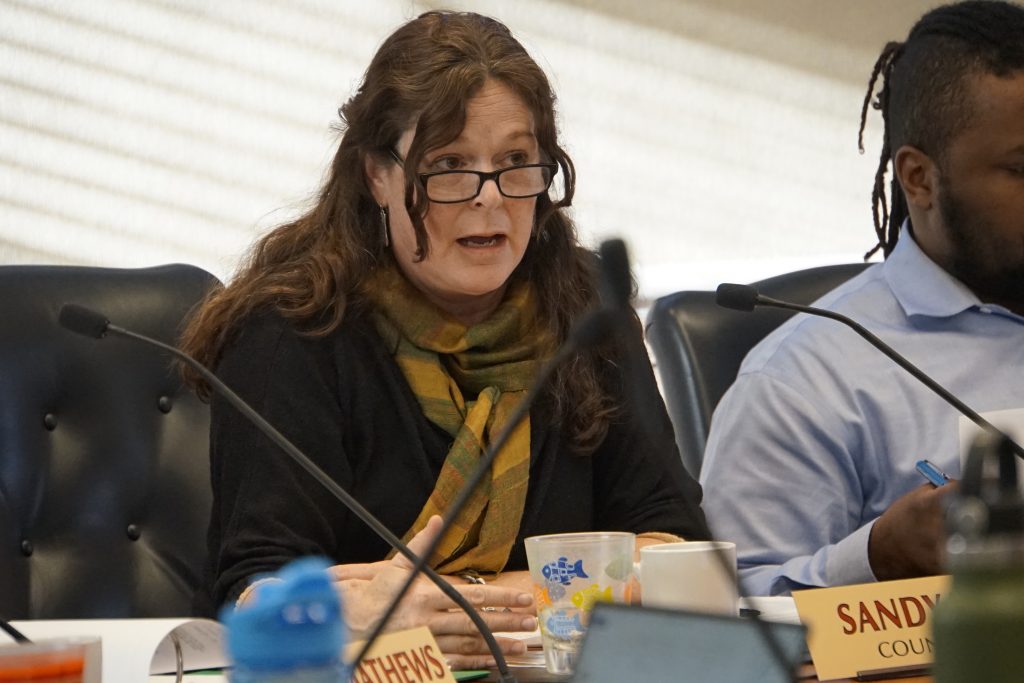
IN THEIR WORDS
Why did councilmembers vote yes or no on the 20% inclusionary rate?
VICE MAYOR DONNA MEYERS (voted no): “Right now the way we’re approaching this is we are setting the risk level by this policy approach and I think people are going to stop investing in our community. I really believe that. It’s going to be easier for them and more predictable for people who do this work to go to other communities and spend their dollars doing that, and they’ll just let the pieces that they own here sit. We’re not going to get new housing and we won’t get the type of housing that we’re trying to get.”
COUNCILMEMBER MARTINE WATKINS (voted no): “Where I struggle with this policy particularly is that it feels uncertain on the ‘how.’ And we can all agree on the ‘why,’ but without more certainty in the ‘how,’ it feels like an uninformed policy that could potentially have negative impacts. And at this time when we’re experiencing so many folks leaving this community because of the lack of affordability, I don’t think we want to unintentionally contribute to more lack of affordability.”
COUNCILMEMBER SANDY BROWN (voted yes): “I really feel that it’s important to provide some additional incentive to developers to help us figure out that ‘how.’ Because without the requirement, they have no incentive. They have no reason to come to us and say, ‘Hey we’d like to figure out some way to make this work. Here’s some ideas.’ So having a requirement like this will probably cause them, I mean I’m hoping it causes them, to think about how to make it work.
“Because housing development is costly and it is risky, but it’s also has the potential to be highly lucrative in one of the most expensive land markets in the country, if not the world, and one of the least affordable places to live.”
Mayor Justin Cummings (voted yes) said that several development projects are in the works, and it seems like there’s potential to see state funding for housing this year.
CUMMINGS: “If we were to build on these sites now and it turns out a year from now there’s additional funds or we’re able to come up with innovative ways to make this happen, if those units are built, then there’s no way we can go back. At this point in time I’m hesitant, but going to go forward with this second reading. However, with the caveat: that I think it’s really important that the planning commission and the city council members and folks from the community, that we really work together to try to figure out how to make this work. And should it seem like we may not be able to make it work, we identify the difficulties so that we can adjust the ordinance.”
IN OTHER NEWS
- The city council unanimously approved a full renovation of the Branciforte and Garfield Park libraries. These renovations together are $2 million over budget. The city council approved a plan to allocate an additional $1.5 million of Measure S library bond funds to the projects. Friends of the Santa Cruz Public Libraries, a fundraising nonprofit supporting the library system, has agreed to raise an additional $500,000 for these projects in 2020.
- Renovations for the Branciforte Library include a new community meeting room with wood paneling throughout. The room is designed with its own entries for after-hours functions. The design also includes a new children’s area next to an outdoor patio, a larger teen space and a new reading lounge. The library would remain on the same footprint. Its completion is expected in early 2022.
- Garfield Park Library’s renovations also would maintain the same footprint. That design includes a smaller circulation desk to allow for a larger meeting room. The adult reading room would be refurbished with wood shelving, new furniture and a stone fireplace. Shelving would be moved away from the windows to allow more daylight. The children’s area would include computers, a homework zone, and reading benches in the window boxes. A concrete ramp for wheelchairs at the back of the library would have to be updated to meet code, a large portion of the project’s cost. Completion is expected in mid-2021.
- Councilmembers Chris Krohn, Drew Glover and Mayor Jusin Cummings expressed concern about a gate in the Branciforte Library design that would prevent homeless people from camping next to the entry, and called for flexibility in how the gate is designed and built.
- The city council unanimously advanced a new proposed law that would create a minimum $50 fine for landlords who prevent tenants from posting political signs. Tenants’ free speech rights to post political signs are protected by state law. The new local law would create a penalty.
- The city council unanimously advanced a $15,000 grant for the local emergency homeless shelter nonprofit Warming Center Program. The nonprofit shelters as many as 90 homeless people when the temperature falls below 38 degrees. The nonprofit recently added a shower and laundry program. The city council will make a final decision on the grant at an upcoming meeting, pending a formal proposal from the nonprofit.
- City Manager Martin Bernal announced Tuesday that the 1220 River Street Camp will close Wednesday and will relocate to the National Guard Armory in DelaVeaga Park. The fire marshall will determine the capacity Wednesday, but Bernal hopes it will be at least 80 people, he said. The site will be managed by the Salvation Army.
Kara Meyberg Guzman is the CEO and co-founder of Santa Cruz Local. Prior to Santa Cruz Local, she served as the Santa Cruz Sentinel’s managing editor. She has a biology degree from Stanford University and lives in Santa Cruz.


